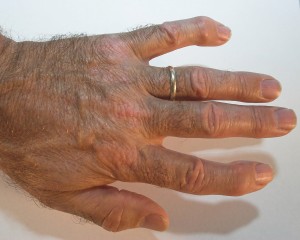This article shows you how to stop suffering from arthritis. Arthritis is an illness of the joints, mostly in older people (osteoarthritis or degenerative arthritis). However, a subgroup of younger patients can also develop a severe form of arthritis, called rheumatoid arthritis where autoimmune antibodies play more of a role.
In the 1950’s Dan Dale Alexander wrote a book called “Arthritis and common sense”. The medical establishment did not accept that simple remedy and Dan Dale Alexander was classified as a “quack”. However, Dr. Mirkin describes a study from Berlin that later confirmed that Dan Dale Alexander’s observation was correct: an emulsion made by shaking orange juice with cod liver oil and taken three times per day on an empty stomach would indeed improve osteoarthritis.
Dan Dale Alexander’s emulsion of orange juice and cod liver oil
In 1966, when I was still a medical student, I suggested to my future mother-in-law to give Dan Dale Alexander’s book about arthritis a try. Despite the well-established osteoarthritic condition in her left knee the arthritis vanished within 6 months and stayed controlled. I could not explain to her why this remedy was effective, as researchers had not yet described higher doses of omega-3 fatty acids and higher doses of vitamin C to be of value for arthritis.
This all changed with the advent of orthomolecular medicine (Ref.1). On page 76 of this book Dr. Frederick Klenner describes that ascorbic acid (vitamin C) at mega doses of at least 10,000 mg daily, but better even between 15,000 and 25,000 mg daily does have healing effects for arthritis. He stated further that repair of collagenous tissue (the joint surfaces) would require adequate ascorbic acid. On page 240 of Ref.1 Dr. Abram Hoffer, the founder of modern orthomolecular medicine reviewed the history of the use of vitamins in higher doses, particularly the use of vitamin B3 (niacin). He also mentioned that Dr. William Kaufman had used mega doses of vitamin B3 for arthritis as far back as 1950.
Overview of arthritis
Dr. Hoffer explains in Ref.2 that arthritis belongs into a group of diseases that are related to faulty nutrition, which in turn lead to vitamin and mineral deficiencies and a pandeficiency disease. Other diseases that belong to that group are cardiovascular disease, multiple sclerosis, cancer, diabetes, schizophrenia, mood disorders, alcoholism and autism. Contributing factors can be poor diets with overemphasis on refined and processed foods and consumption of sugar, allergies, diseases of the gastrointestinal tract and viral infections. Arthritis belongs into this group of illnesses as well. Researchers found that niacin, vitamin B6 and zinc were useful to treat arthritis, but other vitamins and minerals are also necessary. Here is a list of what Dr. Hoffer would suggest to use (Ref. 2):
-
Vitamin B3
Vitamin B3 from 100 mg to several thousand mg three times daily following meals. With niacin there can be skin flushing, which often goes away after the body gets used to the higher doses; but niacinamide could be used instead by those who are bothered by the flushing.
-
B complex
B complex: this contains each of the major B vitamins including vitamin B6 (pyridoxine). Take 100 mg once per day with a meal. The dose for vitamin B6 is up to 500 mg per day or more.
-
Vitamin C
The dosage for vitamin C is between 500 mg and several thousand mg three times per day after meals.
-
Vitamin D3
To get adequate vitamin D3 levels the patient has to take 4000 IU per day in the summer months. In the winter months particularly populations who live far north require 6000 IU per day.
-
Vitamin B1 (thiamine)
Vitamin B1 (thiamine): alcoholics and very high sugar consumers need thiamine at 100 to 500 mg three times per day.
-
Folic acid at mega doses
Folic acid at mega doses (prescription needed) works as an antidepressant, which requires 25 to 50 mg. To lower homocysteine levels lower doses of folic acid are sufficient.
-
Vitamin E
Vitamin E: usually 400 IU to 800 per day. Muscle wasting diseases, Huntington’s disease and amyotrophic lateral sclerosis (ALS) require much higher doses up to 4000 IU per day.
-
Essential fatty acids (omega-3)
Essential fatty acids (omega-3): It is strongly recommended to use a molecularly distilled product, which is free of mercury and PBC’s at 1000 mg three times daily following meals.
-
Selenium
Selenium: The required dosage is 200 to 600 micrograms once daily (with any meal). In areas where selenium is deficient, this is particularly important.
-
Zinc
Zinc: 50 mg of zinc citrate or 220 mg of zinc sulfate once per day with a meal.
-
Calcium and magnesium
Calcium and magnesium: Dr. Hoffer suggested 1000 mg of calcium with 500 mg of magnesium, although many experts now say that 1000 mg of calcium with 1000 mg of magnesium may be better.
Dr. Hoffer pointed out that this program is compatible with any medication and is non-toxic.
Thoughts on treating arthritis
1. Conventional methods
The conventional approach to treatment of arthritis consists of anti-inflammatory medications like ANSAIDs. Unfortunately they have side effects like causing kidney damage after several years of use. Also, NSAIDs can lead to gastric bleeding from gastric erosions, which may require blood transfusions. Physiotherapy with reactivation and swimming have been found to be useful. Electro acupuncture can help for pain control.
2. Diet changes, multivitamins and minerals
As arthritis occurs mostly in civilized nations, physicians have long suspected dietary factors to be of importance. Dr. Hoffer pointed out that arthritis is a pandeficiency disease meaning that overconsumption of sugar and processed foods has lead to multiple vitamin and mineral deficits that interfere with the cartilage metabolism leading to premature breakdown of cartilage and causing inflammation. It is not good enough to just take the supplements listed above; this needs to be combined with a fundamental change in diet. Cut out sugar and starchy foods. Return to homemade foods. Keep it simple with lots of vegetables, salads and organic meats. Now that you are starting to turn around your metabolism by a sensible diet the supplements listed above have a chance to work.
You will notice that Dan Dale Alexander’s idea of omega-3 fatty acids and vitamin C (from the freshly pressed orange juice) is contained in the list of supplements above. Dr. Klenner’s mega doses of vitamin C are also listed and Dr. Kaufman’s mega doses of vitamin B3 is contained in this list as well.
This list may not have been formally researched with controlled clinical trials, because the food industry and the makers of NSAIDs (Big Pharma) have no interest in this. But thousands of patients have been empirically treated with this regimen and a network of orthomolecular physicians has established that this regimen works to control the inflammation of arthritis and at the same time has no toxic side-effects.
3. Laser, platelet rich plasma (PRP) and stem cells
Blue and green lasers have anti-inflammatory properties and are suitable for interstitial and intra articular laser treatments of arthritis. Dr. Weber has extensive experience with this treatment modality in Germany. I have discussed this in another blog.
However, prolotherapy, PRP and stem cell treatments are also an option for more severe cases of arthritis, particularly in arthritis of the knees, which can avoid total knee replacement surgery.
Conclusion
I met Dr. Hoffer in the early 1980’s during a meeting in Vancouver, BC when he wanted to establish a local orthomolecular division for British Columbia. Although I found the ideas fascinating, I felt that the College of Physicians and Surgeons (the regulatory body for physicians in BC) would scrutinize the practice of any orthomolecular member. At that time I would risk losing my license to practice medicine, which I just had received in 1978. So I decided not to join. Interestingly enough later in the 1980’s a member of the orthomolecular society of BC lost his license because of the use of mega doses of intravenous vitamin C. At this time the College considered these infusions useless or hazardous. Nowadays, any naturopathic and orthomolecular physician uses these intravenous vitamin C treatments as standard therapies. It shows how times have changed.
Lifestyle issues important with causation of arthritis
What has not changed is the food industry that undermines our health every day with hidden sugar contained in processed foods. In social functions it is customary to have a drink or two, if not more, which uses up our thiamine faster than we can replace it. Pan deficiency disease is alive and well as it was many years ago. It is in front of our eyes, but can we see it? Depending on what your eating habits are, do you need to make changes in your diet and perhaps take some or all of the ingredients of the multivitamin and mineral list above? Start by adopting a Mediterranean type diet, then add some of the supplements listed above. It is time to take a thorough look at natural treatment modalities against arthritis in the interest of preserving your health!
References
Ref. 1: Andrew W. Saul, Ph.D.: “The Orthomolecular Treatment of Chronic Disease. 65 Experts on Therapeutic and Preventative Nutrition”, Basic Health Publications, Laguna Beach, CA, 2014.
Ref. 2: Chapter in Ref. 1 by Dr. Hoffer: “Pandeficiency Disease”, pages 24-30 (2014).








